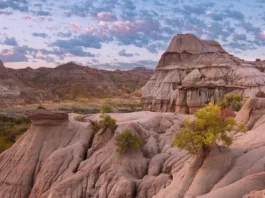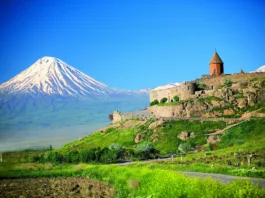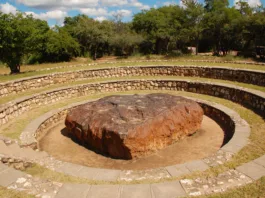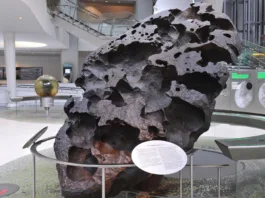Mono Lake is a fascinating and unique natural wonder located in eastern California, United States. It is situated in the Great Basin, east of the Sierra Nevada mountain range, near the town of Lee Vining. What makes Mono Lake particularly remarkable is its extraordinary geological and ecological features, as well as its historical and cultural significance.
The lake basin was formed over 700,000 years ago as a result of volcanic activity and tectonic forces. It is a saline soda lake, meaning it has high levels of salt and alkali minerals. The water of Mono Lake is highly alkaline, with a pH level around 10, making it inhospitable for most forms of aquatic life.
One of the most visually striking features of Mono Lake is its collection of tufa towers. These towering limestone formations were created by the interaction of freshwater springs and the alkaline lake water. Over time, calcium-rich freshwater from underground sources mixes with the carbonate-rich lake water, resulting in the precipitation of calcium carbonate and the gradual growth of the tufa towers.

Mono Lake holds significant ecological importance. Despite its harsh conditions, it supports a unique ecosystem and provides habitat for various species of birds, insects, and alkali flies. The lake is a critical stopover for millions of migratory birds along the Pacific Flyway, serving as a vital resting and feeding site.
Throughout history, Mono Lake has been significant to Native American tribes such as the Kutzadika’a Paiute and the Sierra Miwok. These tribes revered the lake and relied on its resources for sustenance and cultural practices. With the arrival of European settlers and the establishment of mining and agriculture in the region, Mono Lake faced numerous environmental challenges, particularly due to water diversions.
The diversion of water from the lake’s tributary streams to meet the growing water demands of Los Angeles through the Los Angeles Aqueduct caused a significant drop in Mono Lake’s water level. This led to the exposure of previously submerged tufa formations and the deterioration of the lake’s ecosystem. Legal battles and conservation efforts ensued, resulting in landmark decisions to protect and restore Mono Lake.
Today, Mono Lake attracts visitors from around the world who come to witness its otherworldly beauty, learn about its unique geology and ecology, and engage in recreational activities such as bird-watching, kayaking, and hiking. The lake is also a site of ongoing scientific research and monitoring, contributing to our understanding of hydrology, geology, and the delicate balance between human needs and environmental preservation.
Preserving Mono Lake is of paramount importance to maintain its ecological integrity, protect its fragile ecosystem, and ensure its cultural and historical significance endures for future generations.

Contents
Geological Formation of Mono Lake
The geological formation of Mono Lake is a fascinating process that spans millions of years and involves volcanic activity and tectonic forces. Understanding its geological history helps shed light on the unique characteristics of the lake and its surroundings.
The origins of Mono Lake can be traced back to the Long Valley Caldera, a massive volcanic depression located in the eastern Sierra Nevada region. Approximately 700,000 years ago, a violent volcanic eruption occurred, resulting in the formation of this caldera, which measures about 20 miles (32 kilometers) wide and 10 miles (16 kilometers) long.
Over time, subsequent eruptions and volcanic activity within the caldera contributed to the formation of the basin that eventually became Mono Lake. The accumulation of volcanic material, including ash, pumice, and lava flows, created a layered landscape that gradually shaped the lake basin.
One of the most significant volcanic features in the area is the Mono Craters, a collection of small volcanic domes and cones situated to the south of Mono Lake. These craters are a testament to the volcanic activity that shaped the region. The youngest of the Mono Craters is the Panum Crater, estimated to be around 600 to 700 years old.
The tectonic activity in the region also played a crucial role in the formation of Mono Lake. The area lies within the Walker Lane, a geological region characterized by intense faulting and horizontal movement. The movement along the faults, including the nearby Mono-Inyo Craters volcanic chain, caused the subsidence of the caldera floor and contributed to the basin’s formation.
The unique chemical composition of Mono Lake can be attributed to its geological history. The lake’s water is rich in salts and minerals due to the leaching and dissolution of materials from the surrounding volcanic rocks and sediments. As water flows into the lake from tributary streams and underground sources, it carries dissolved minerals such as sodium carbonate, calcium, and magnesium, resulting in the high salinity and alkalinity of the lake.
The geological processes that shaped Mono Lake continue to influence its dynamics. The lake’s water level fluctuates over time due to factors such as snowmelt, precipitation, and evaporation. Changes in the hydrological balance can expose or submerge the tufa formations that are an iconic feature of the lake.
Overall, the geological formation of Mono Lake is a complex interplay between volcanic activity, tectonic forces, and hydrological processes. It is this combination of factors that has given rise to the unique geological and chemical characteristics that make Mono Lake a captivating natural wonder.

Physical Characteristics of Mono Lake
Mono Lake possesses distinctive physical characteristics that contribute to its unique allure. These characteristics encompass its size, depth, volume, water salinity, alkalinity, and the peculiar chemical composition of its waters.
Size: Mono Lake spans an area of about 70 square miles (180 square kilometers). While not one of the largest lakes in the world, it is a significant body of water in the region.
Depth: The average depth of Mono Lake is around 57 feet (17 meters). However, it exhibits considerable variations in depth across its different sections. Some areas near the shore are quite shallow, while the lake’s deepest point plunges to approximately 159 feet (48 meters).
Volume: The lake contains an estimated volume of 4.3 cubic miles (18 cubic kilometers) of water. This volume fluctuates over time due to the interplay of precipitation, evaporation, and water inflows from tributary streams.
Water Salinity and Alkalinity: Mono Lake is renowned for its high salinity and alkalinity. The salinity of its waters is roughly 2 to 3 times saltier than the ocean. The alkalinity of the lake is attributed to the presence of carbonates and bicarbonates, which contribute to its pH level of around 10. This alkalinity makes Mono Lake one of the most alkaline lakes globally.
Chemical Composition: The unique chemical composition of Mono Lake is a result of various geological and hydrological processes. The lake’s waters are rich in dissolved salts and minerals, particularly sodium carbonate, calcium, and magnesium. These elements are derived from the volcanic rocks and sediments in the surrounding area. The interaction between the lake’s alkaline waters and freshwater springs gives rise to the formation of tufa towers, which are composed of calcium carbonate deposits.
Apart from these physical characteristics, the lake’s water level is subject to considerable fluctuations. It experiences changes in response to seasonal variations, annual precipitation, and the diversion of water for human use. These fluctuations impact the exposed shoreline, revealing tufa formations or submerging them beneath the water’s surface.
The physical characteristics of Mono Lake, including its size, depth, salinity, alkalinity, and chemical composition, make it a unique and intriguing natural feature. These factors contribute to the lake’s distinctive ecology, geology, and overall aesthetic appeal.

Tufa Towers at Mono Lake
The tufa towers at Mono Lake are one of its most iconic and visually striking features. These towering limestone formations are created through a unique process that involves the interaction of freshwater springs and the alkaline waters of the lake. The tufa towers contribute to the otherworldly beauty and ecological significance of Mono Lake.
Formation Process: The formation of tufa begins with the underwater springs found beneath Mono Lake. These springs carry freshwater laden with dissolved calcium carbonate. As the freshwater mixes with the alkaline lake water, a chemical reaction occurs. The calcium carbonate precipitates out of the water, forming solid deposits of tufa.
Over time, layer upon layer of tufa is built up around the springs. The growth of tufa is a slow process, occurring at a rate of about one foot every 100 years. The size and shape of the tufa formations can vary widely, ranging from small cones to massive towers reaching heights of over 30 feet (9 meters).
Ecological Significance: The tufa towers play a vital role in the ecology of Mono Lake. They provide nesting sites and perches for a variety of bird species, including gulls, terns, and phalaropes. These birds utilize the towers as safe platforms for resting, preening, and raising their young. The tufa formations also serve as habitats for insects and other small invertebrates.
Impact of Water Level Changes: The water level fluctuations of Mono Lake have a direct impact on the exposure or submergence of the tufa towers. When the lake’s water level drops, due to natural factors or human water diversions, more tufa formations become exposed and visible along the shoreline. Conversely, during periods of high water levels, the tufa towers can be partially or completely submerged.
Conservation and Protection: The tufa towers at Mono Lake are not only aesthetically captivating but also fragile and vulnerable to damage. To protect these unique geological formations, various conservation efforts have been implemented. Access to certain tufa areas may be restricted to prevent disturbances or harm, and guidelines for responsible visitation are encouraged to preserve the integrity of the tufa formations and the lake ecosystem as a whole.
The tufa towers are a testament to the geological and ecological wonders of Mono Lake. Their ethereal beauty and ecological significance make them an integral part of the lake’s charm and serve as a reminder of the delicate balance between nature and human interaction.

Recreational Activities and Tourism
Recreational activities and tourism at Mono Lake offer visitors the opportunity to explore and appreciate the natural beauty, unique ecology, and cultural significance of the area. The lake and its surroundings provide a range of activities that cater to different interests and promote responsible enjoyment of the region.
- Bird-Watching: Mono Lake is a crucial stopover for millions of migratory birds along the Pacific Flyway. Bird enthusiasts can observe a diverse array of avian species, including gulls, terns, phalaropes, and numerous waterfowl. The lake’s shoreline and nearby wetlands offer excellent bird-watching opportunities.
- Kayaking and Canoeing: The calm and relatively shallow waters of Mono Lake make it suitable for kayaking and canoeing. Visitors can paddle along the lake’s shoreline, explore its unique tufa formations up close, and enjoy panoramic views of the surrounding mountains.
- Hiking and Nature Trails: Several hiking trails traverse the Mono Basin, offering stunning vistas and opportunities to immerse oneself in the area’s natural beauty. The trails vary in difficulty, ranging from leisurely walks to more challenging hikes. Visitors can discover diverse flora, observe wildlife, and learn about the geological and cultural history of the region.
- Scenic Photography: Mono Lake’s dramatic landscape, tufa towers, and stunning sunrises and sunsets make it a paradise for photographers. The play of light and shadow on the lake’s surface and the unique formations provide endless creative possibilities.
- Educational Programs and Visitor Centers: Mono Lake is home to several visitor centers and educational programs that offer insights into the lake’s ecology, geology, and cultural heritage. These centers provide interpretive displays, guided tours, and workshops to enhance visitors’ understanding and appreciation of the area.
- Star Gazing: The clear night skies and minimal light pollution in the Mono Basin make it an ideal location for stargazing. Visitors can marvel at the countless stars, observe celestial phenomena, and engage in astrophotography.
It’s important to note that responsible tourism practices are encouraged to protect the fragile ecosystem of Mono Lake. Visitors should adhere to designated trails, respect wildlife habitats, and follow guidelines for waste management and leave-no-trace principles.
Mono Lake’s recreational activities and tourism offerings allow visitors to connect with nature, experience its beauty, and deepen their understanding of the lake’s ecological and cultural importance. By engaging in responsible tourism practices, visitors can help preserve this unique destination for future generations to enjoy.

Water Management and Environmental Issues
Water management and environmental issues have played a significant role in the history and conservation efforts surrounding Mono Lake. The lake has faced challenges stemming from water diversions, resulting in a drop in water levels and ecological consequences. Here are some key points related to water management and environmental issues at Mono Lake:
- Los Angeles Aqueduct: In the early 20th century, water diversions from Mono Lake’s tributary streams began as part of the Los Angeles Aqueduct project. The aqueduct was constructed to supply water to the growing city of Los Angeles, located hundreds of miles to the south.
- Water Level Decline: The water diversions led to a significant decline in the lake’s water level, exposing previously submerged lakebed and tufa formations. Between 1941 and 1994, Mono Lake dropped by approximately 45 feet (14 meters) due to these diversions.
- Ecological Consequences: The water level decline had adverse effects on the lake’s ecosystem. The exposed shoreline resulted in the loss of critical habitat for various bird species, including nesting and foraging areas. Reduced water volume also increased the lake’s salinity and alkalinity, affecting the survival of aquatic organisms.
- Legal Battles: Concerned individuals and environmental organizations recognized the ecological importance of Mono Lake and its surrounding areas. Legal battles ensued, culminating in a landmark decision in 1983 by the California State Water Resources Control Board. The decision mandated the protection of Mono Lake and its ecosystem, establishing minimum water levels and ensuring the lake’s preservation.
- Restoration Efforts: Following the legal decision, restoration efforts were initiated to raise the water levels and mitigate the ecological impacts. These efforts involved implementing water management plans, such as the Mono Lake Committee’s “Save Mono Lake” campaign. Additionally, water conservation measures were implemented in Los Angeles to reduce reliance on Mono Lake’s water.
- Cooperative Agreements: Collaborative efforts between conservation groups, state agencies, and the Los Angeles Department of Water and Power resulted in cooperative agreements for sustainable water management. These agreements aimed to strike a balance between meeting urban water needs and maintaining the ecological health of Mono Lake.
- Environmental Monitoring: Ongoing environmental monitoring programs assess water quality, bird populations, tufa formation health, and other ecological indicators. These monitoring efforts help track the recovery of the lake and guide adaptive management strategies.
- Environmental Education and Awareness: Various educational programs, visitor centers, and outreach initiatives raise awareness about the environmental issues facing Mono Lake. They promote understanding of the lake’s ecological significance and encourage responsible stewardship.
Efforts to restore and protect Mono Lake have been successful, with the water level gradually rising and the ecosystem showing signs of recovery. However, continued vigilance and adaptive management are necessary to ensure the long-term sustainability and preservation of this unique and fragile ecosystem.

Recap of Mono Lake’s significance and uniqueness
Mono Lake’s significance and uniqueness can be summarized as follows:
- Geological Wonder: Mono Lake is a geological marvel, formed within the Long Valley Caldera through volcanic activity and tectonic forces. Its distinctive features, including tufa towers and volcanic formations, showcase the area’s dynamic geological history.
- Saline Soda Lake: The high salinity and alkalinity of Mono Lake make it a rare example of a saline soda lake. The lake’s unique chemical composition and alkaline pH level contribute to its ecological distinctiveness.
- Tufa Towers: The towering tufa formations at Mono Lake are visually stunning and result from the interaction of freshwater springs and the alkaline lake water. These formations provide habitats for various bird species and add to the lake’s ethereal beauty.
- Ecological Importance: Mono Lake supports a unique ecosystem, serving as a vital stopover for migratory birds along the Pacific Flyway. It provides nesting grounds, food sources, and resting areas for a diverse range of bird species and other wildlife.
- Cultural Significance: Mono Lake holds cultural and historical importance for Native American tribes, including the Kutzadika’a Paiute and Sierra Miwok. The lake and its resources have been integral to their traditional practices and sustenance.
- Water Management Challenges: The lake has faced environmental challenges due to water diversions for the Los Angeles Aqueduct. This resulted in a drop in water levels, ecological disruptions, and legal battles for the lake’s protection.
- Conservation Success: The conservation efforts and legal decisions to protect Mono Lake have led to its gradual restoration. Through cooperative agreements, water management plans, and ongoing monitoring, the lake’s ecosystem has shown signs of recovery.
- Recreational and Educational Opportunities: Mono Lake offers a range of recreational activities such as bird-watching, kayaking, hiking, and stargazing. Visitor centers and educational programs provide insights into the lake’s ecology, geology, and cultural heritage.
- Environmental Awareness: Mono Lake has become a symbol of environmental awareness and responsible water management. It highlights the importance of balancing human needs with the preservation of fragile ecosystems.
Mono Lake’s significance and uniqueness lie in its geological, ecological, and cultural features. The restoration and conservation efforts have helped preserve this extraordinary natural wonder, ensuring its ecological integrity and cultural value for generations to come.
FAQs
Where is Mono Lake located?
Mono Lake is located in eastern California, in the Mono Basin, between the Sierra Nevada mountain range to the west and the Great Basin to the east.
Why is Mono Lake so salty?
Mono Lake is highly saline due to the high concentration of dissolved salts and minerals in its waters. These salts and minerals come from the surrounding volcanic rocks and sediments, which leach into the lake over time.
What are tufa towers?
Tufa towers are tall, calcium carbonate formations that rise above the surface of Mono Lake. They are created through a chemical reaction between freshwater springs and the alkaline lake water. Over time, layers of calcium carbonate build up and form these unique and visually striking structures.
What is the significance of Mono Lake’s ecosystem?
Mono Lake’s ecosystem is significant as a vital stopover for millions of migratory birds along the Pacific Flyway. It provides critical nesting and foraging habitats for various bird species. The lake’s unique chemistry also supports a diverse array of aquatic organisms.
How has Mono Lake been impacted by water diversions?
Water diversions from Mono Lake’s tributary streams for the Los Angeles Aqueduct led to a significant decline in the lake’s water level. This caused ecological disruptions, loss of habitat, increased salinity, and alkalinity. However, conservation efforts and legal decisions have aimed to mitigate these impacts and restore the lake’s health.
Can I visit Mono Lake?
Yes, Mono Lake is open to visitors. There are several access points around the lake, and recreational activities such as bird-watching, hiking, kayaking, and photography are popular. It is important to follow responsible tourism practices and respect the fragile ecosystem of the lake.
Are there camping facilities near Mono Lake?
Yes, there are camping facilities available near Mono Lake. Both public and private campgrounds can be found in the Mono Basin and nearby areas. It is advisable to check for availability and make reservations in advance.
What is the best time to visit Mono Lake?
The best time to visit Mono Lake largely depends on personal preferences. Spring and fall offer pleasant weather and are popular for bird-watching and wildflower blooms. Summer can be hot but allows for water-based activities. Winter brings colder temperatures and potential snowfall, creating a serene and picturesque atmosphere.
Are there guided tours or educational programs available at Mono Lake?
Yes, there are guided tours and educational programs available at Mono Lake. The Mono Lake Committee and other organizations offer guided tours, workshops, and educational resources that provide insights into the lake’s ecology, geology, and cultural significance.






